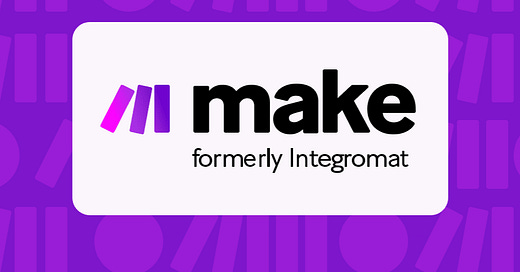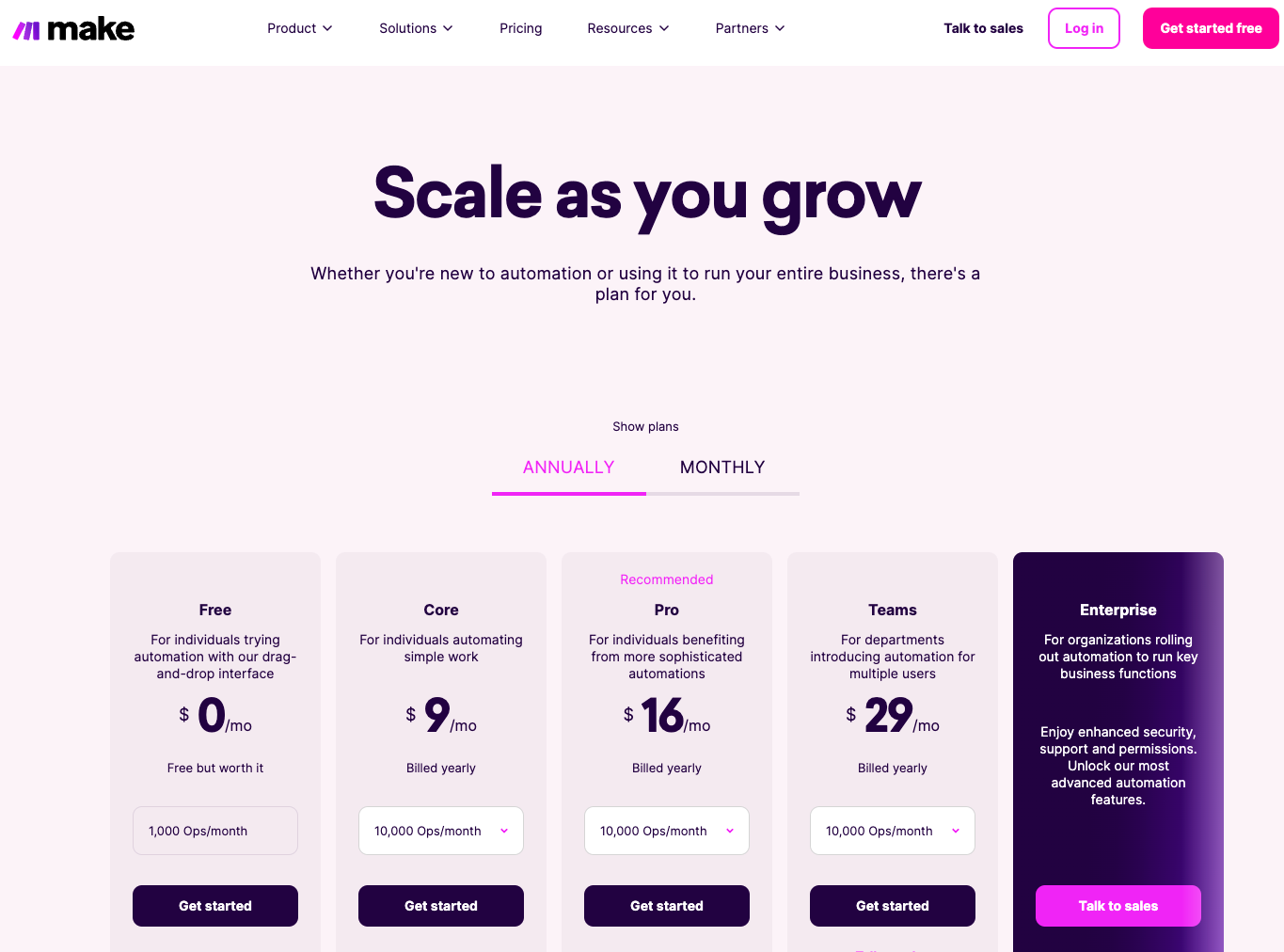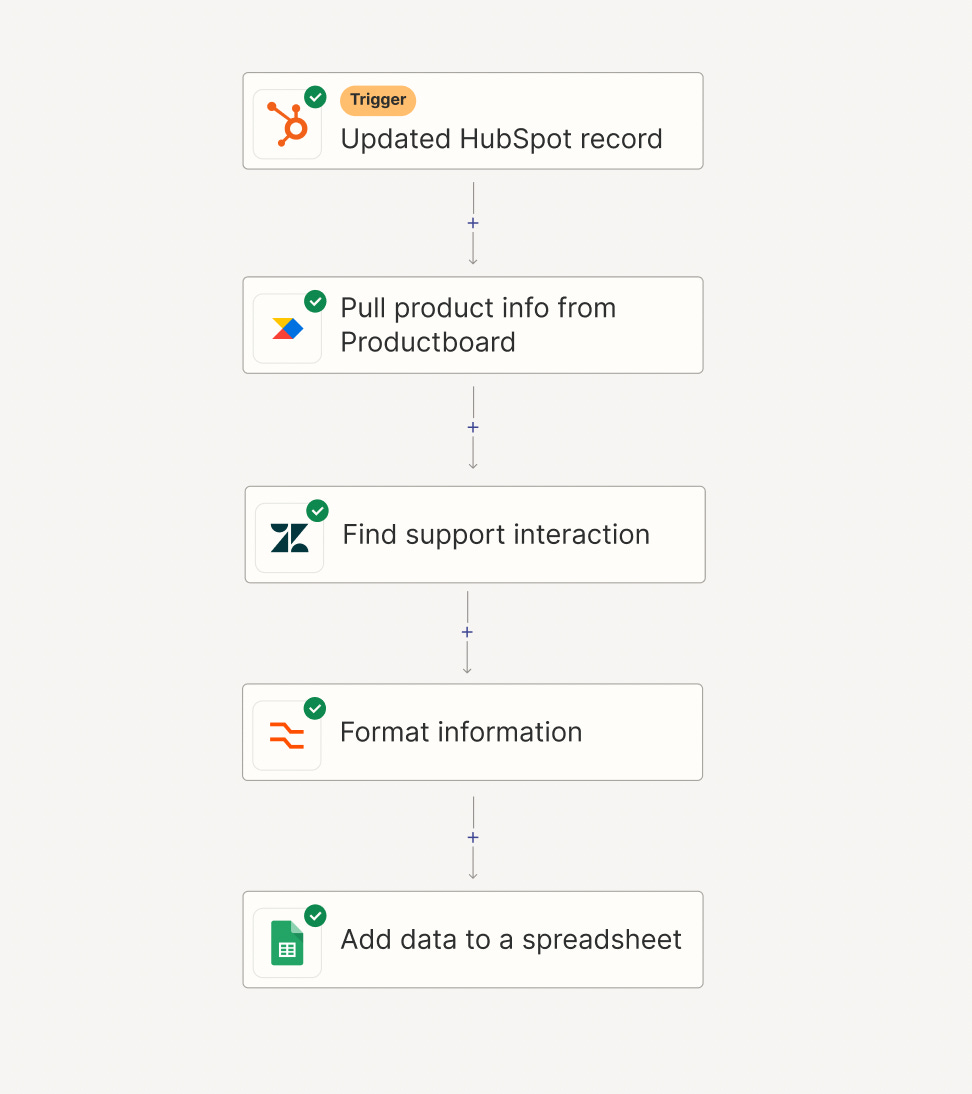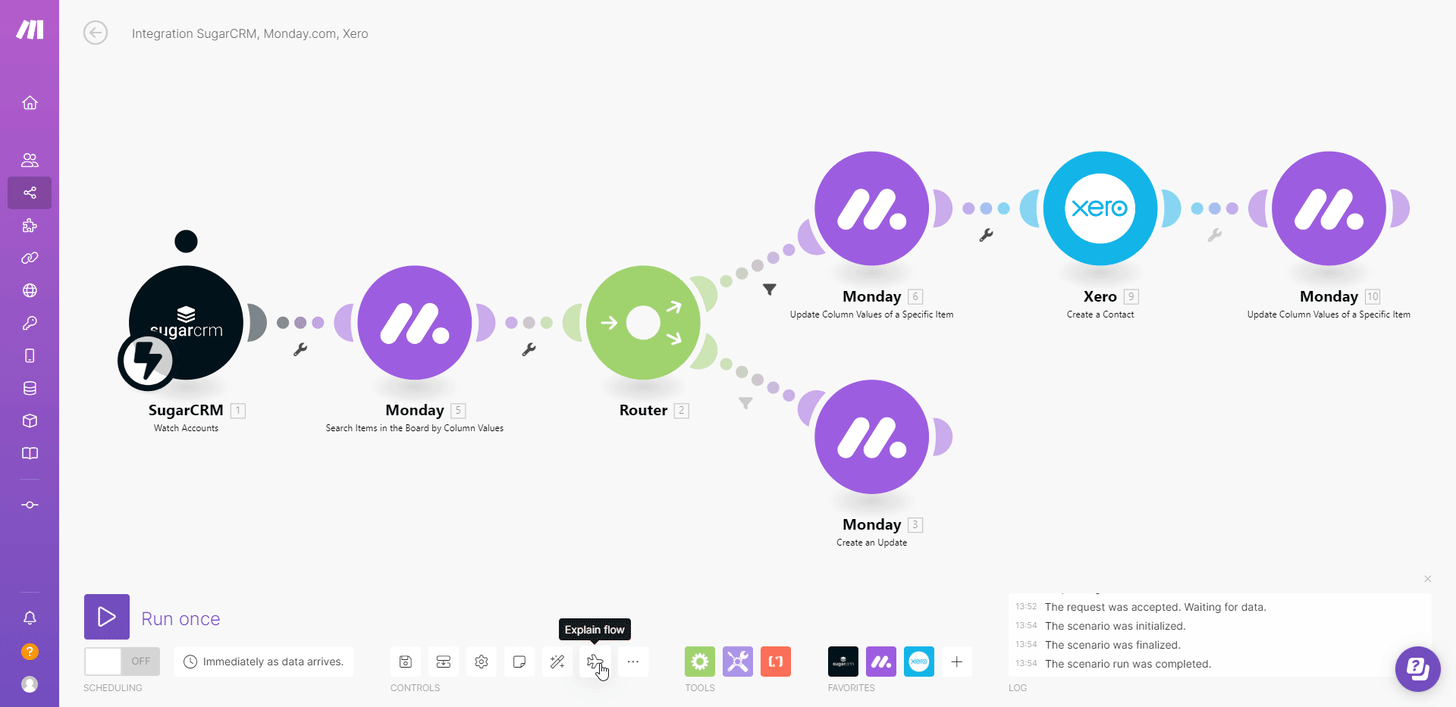An Introduction to Make: AI & Automation for Business
The Future of AI Business Automation: Why Make.com is Leading the Charge
AI Tool: Make
Level: Intermediate
Access: Free
This guide is part 1 of the course Learn Make: AI & Automation for Business.
So how can AI & automation help businesses?
What's the difference between AI & automation?
You might have already used AI tools like ChatGPT or Claude and found it useful.
But what’s the best way to use AI & automation in business, at scale?
Make is one of the leading platforms that helps businesses use AI & automation to solve practical business problems at scale.
In this guide, we will cover:
What is Make
Make vs ChatGPT
Understanding AI & Automation
Make AI Automation Business Use-Cases
Make vs Zapier: Pros and Cons
Why Make is Better than Zapier
What is Make
Make.com is a powerful automation platform that's transforming the way businesses and individuals handle repetitive tasks and workflows using AI and automation.
Think of Make.com as a digital brain that can connect different apps and services with intelligence, allowing them to combine seamlessly to work for you and do tasks without you having to perform repetitive actions.
Make vs. ChatGPT
While AI tools like ChatGPT and Claude have gained significant attention for their ability to generate human-like text and assist with various tasks, automation platforms like Make.com serve a different, yet crucial purpose in the AI ecosystem.
Focused Problem-Solving
Make.com is designed to solve specific, real-world business problems by automating workflows and connecting different applications.
Unlike general AI tools that provide broad assistance, Make.com offers targeted solutions for streamlining specific business operations & tasks and improving efficiency.
Integration Capabilities
While ChatGPT and Claude excel at natural language generation, they are unable to interact directly with other software and services.
Make.com, on the other hand, can seamlessly integrate with over 1,000 apps, such as Google Sheets, Hubspot and more - allowing for practical, real-time automation of business processes.
Customisation and Control
Make.com provides users with granular control over their automated workflows.
This level of customisation ensures that the automation aligns perfectly with specific business needs, something that general AI tools like ChatGPT cannot offer.
Consistent and Reliable Execution
Unlike AI language models alone that may produce varying outputs, Make.com can execute predefined workflows consistently, ensuring reliability in business operations, while also integrating AI in a way that's more reliable and predictable.
In essence, while general AI tools like ChatGPT and Claude are helping us understand AI's potential, automation platforms like Make.com are making AI and automation more applicable and useful for solving specific business problems.
Understanding AI and Automation
Automation and Artificial Intelligence (AI) are often used interchangeably, but they are not quite the same thing - they serve distinct purposes and operate on fundamentally different principles.
Understanding these differences is crucial for businesses and professionals interested in using these technologies.
Automation:
Primary Functionality: Automation focuses on executing simple repetitive tasks with precision and consistency, often replacing manual labour with predictable processes. It uses predefined simple rules and sequences, doing best at standardised tasks but struggling with unforeseen variations.
Key Features: Rule-based, pre-defined instructions, simple repetitive tasks & logic, no learning or adaptation, and limited to well-defined processes.
Artificial Intelligence (AI):
Primary Functionality: AI mimics human cognitive functions, learning from data and adapting to new information to tackle complex problems. It uses artificial neural networks to process information, similar to our brains, to learn from experience, and make informed decisions.
Key Features: Learning-based, adapts and improves from experience, complex tasks requiring cognitive abilities, decision-making based on data and learning, and highly adaptable to new situations.
So, while both automation and AI aim to streamline tasks traditionally performed by humans, they operate on very different principles.
Understanding these key differences is important for being able to use these technologies effectively in business and beyond, by understanding the range of tasks each is capable of.
Make.com combines access to both AI and automation to create a platform where users can set up "scenarios" - automated workflows that perform actions across multiple apps based on specific triggers or conditions, using AI and/or automation as required.
Key Features of Make.com
Make.com offers many features that make it a versatile tool for AI automation:
Visual Workflow Builder: Create complex automations using a drag-and-drop interface.
Wide Range of Integrations: Connect with over 1,000 apps and services.
Data Mapping: Easily transfer and transform data between different apps.
Error Handling: Built-in mechanisms to manage and notify you of any issues in your automation.
Scheduling: Set up automation to run at specific times or intervals.
Make AI Automation Business Use Cases
Make.com can be applied to various scenarios across different industries.
Here are some examples:
Customer Support: Automatically create support tickets from customer emails and assign them to the appropriate team member.
Social Media Management: Schedule and post content across multiple platforms, and collect engagement metrics in a centralised dashboard.
E-commerce: Update inventory levels across different sales channels when a sale is made on any platform.
Lead Generation: Automatically add new leads from various sources (e.g., website forms, social media) to your CRM and trigger follow-up emails.
Data Analysis: Collect data from multiple sources, process it, and generate reports automatically.
Make.com vs. Zapier: Pros and Cons
I've written previous guides about the Zapier automation platform.
Both Make.com and Zapier are the leading automation platforms, but they have some key differences:
Make.com
Pros:
More affordable, especially for high-volume automation
Offers more complex and customisable workflows
Provides detailed control over data handling and transformations
Cons:
The steeper learning curve for beginners
Fewer pre-built templates compared to Zapier
Zapier
Pros:
Easier to use for beginners
A larger number of app integrations (over 5,000)
More pre-built templates for quick setup
Cons:
Can be more expensive, especially for businesses with high automation needs
Less flexibility for complex workflows
While Zapier might be more user-friendly for absolute beginners, Make.com offers more advanced features and better value for money as your automation needs grow.
Make.com's visual approach to creating workflows and its ability to handle complex scenarios make it a powerful tool for businesses looking to scale their automation efforts.
Make.com is an excellent choice for those looking to harness the power of AI and automation to streamline their workflows, to solve the widest range of business problems.
Its intuitive interface, combined with powerful features and lower cost, makes it possible for anyone to create sophisticated automation using AI that can significantly boost productivity and efficiency.
Why Make is Better than Zapier
While both Make.com and Zapier are powerful automation platforms, having now used both I believe Make.com offers several distinct advantages that make it a superior choice for most businesses, especially those looking to solve the widest range of business problems.
Cost-Effectiveness
Make.com provides significantly better value for money compared to Zapier, especially for businesses with high-volume automation needs.
The pricing structure of Make.com is more flexible and scalable, allowing users to get more operations and features at a lower cost.
This makes it an attractive option for both small businesses looking to grow and larger enterprises seeking to optimise their expenses.
Complex Automation Capabilities
Make.com excels in handling complex, multi-step automation that Zapier’s simple workflow struggles with.
Make’s visual workflow builder allows users to create intricate scenarios with branching logic, loops, and aggregations.
This level of complexity is often necessary for businesses with sophisticated processes, and Make.com delivers it without compromising on user-friendliness.
Advanced-Data Handling
Make.com offers superior data manipulation capabilities compared to Zapier.
Users can perform complex data transformations, and even use built-in tools for text manipulation.
This makes Make.com particularly useful for scenarios involving data analysis, reporting, and complex data integrations.
AI Integration
While both platforms offer some AI capabilities, Make.com provides more advanced & varied AI integration options.
Users can use AI services for tasks like creating draft emails, image generation, or music generation within their automation workflows.
This allows for the creation of more intelligent and adaptive automation that can handle complex decision-making processes.
Unlimited Scenarios
Unlike Zapier, which limits the number of Zaps (automations) you can create on lower-tier plans, Make.com allows users to create unlimited scenarios across all its paid plans.
This gives users the freedom to experiment & automate as many processes as they need without worrying about hitting arbitrary limits.
Better Error Handling
Make.com provides more robust error handling and debugging tools compared to Zapier.
This includes detailed execution logs, error notifications, and the ability to retry failed operations automatically.
For businesses relying heavily on automation, this level of reliability and transparency is crucial.
Custom Functionality
Make.com allows users to create custom modules and even integrate with custom APIs, providing a level of flexibility that Zapier doesn't match.
This means that if a specific integration isn't available out of the box, users have the tools to build it themselves.
Summing up
While Zapier remains a solid choice for simple automations, I now see make.com as the superior platform for those seeking more advanced capabilities, cost-effectiveness, and scalability.
This is why my AI Automation Agency will now be moving to using make.com as my primary solutions platform of choice.
Its ability to handle complex automation, integrate AI better, and offer more features at a lower price point makes it an excellent choice for businesses of all sizes looking to use the full power of AI & automation to solve business problems.








